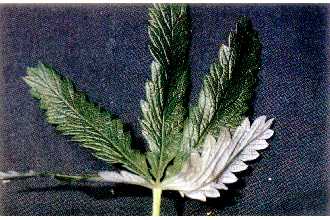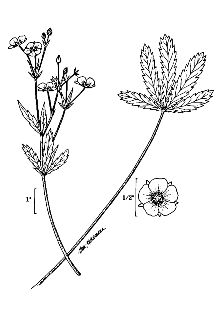Slender Cinquefoil
Scientific Name: Potentilla gracilis Douglas ex Hook.

| General Information | |
|---|---|
| Usda Symbol | POGR9 |
| Group | Dicot |
| Life Cycle | Perennial |
| Growth Habits | Forb/herbSubshrub, |
| Native Locations | POGR9 |
Plant Guide
Use soil moisture sensors to measure the soil moisture of Slender Cinquefoil.
Fact Sheet
Alternative Names
Alternate Common Names: northwest cinquefoil, graceful cinquefoil, western cinquefoil, prairie cinquefoil, fivefinger cinquefoil, cinquefoil, five-finger, graceful five-finger, northwest fivefinger, slender potentilla Alternate Scientific Names: None
Uses
Pollinator habitat: Slender cinquefoil serves as a nectar and/or pollen source for European honey bees, native bees, butterflies, and other beneficial insects, It is also a possible butterfly host plant for the purplish copper (Lycaena helloides) and two-banded checkered skipper (Pyrgis ruralis), Use soil moisture sensors to measure the soil moisture of Slender Cinquefoil., Ornamental: Slender cinquefoil is an attractive plant for perennial garden borders, wildflower meadows, openings in a woodland or wildlife garden, or around a pond, Aside from the beautiful early-summer golden blooms, plants have attractive seed heads, showy fall foliage that turns shades of pink, orange and yellow, and are generally deer-resistant, Restoration: Slender cinquefoil is an important component of many native meadow and prairie ecosystems, Restoration projects in these habitats should consider including this hardy, perennial wildflower in seed mixes, Ethnobotanic: This plant was used for medicinal purposes by tribes of the Pacific Northwest, The Okanagan-Colville took an infusion of pounded roots as a tonic for the blood, general aches and pains, diarrhea, and gonorrhea, or used the infusion to wash sores, The Thompson Indians used a poultice of mashed leaves and roots on wounds to draw out the pain,
Status
This species is considered a facultative wetland plant in California, meaning it usually occurs in wetlands, but it can also occur in non-wetlands throughout its native range. Please consult the PLANTS Web site and your State Department of Natural Resources for this plant’s current status (e.g., threatened or endangered species, state noxious status, and wetland indicator values).
Description and Adaptation
Adaptation
Adaptation
Slender cinquefoil, a member of the rose family (Rosaceae), is a common, native, tufted perennial wildflower that grows from a short, thick rhizome or branched woody crown. Stems are brown-scaly at the base and more or less ascending, extensively branched upwards, bearing short-woolly to long-spreading hairs, and reaching 8 to 40 inches long. The leaves are gray-green, oval, 2 ½ to 12 inches wide, divided from a single point into 5 to 9 inversely-lance-shaped, sharply toothed leaflets. The underside of the leaves is usually white silky-hairy, while the upper surface is green with some hairs. Basal leaves are on long stems that can reach 12 inches in length. Flower clusters are loose and consist of a few to many golden yellow flowers with five heart-shaped petals that are 1/8 to 2/3 inch long. Flowering period is June to September. The fruits are achenes that are less than 1/16 inch, more or less smooth, and light brown. Slender cinquefoil is highly variable, with a number of ill-defined varieties that sometimes inter-grade across their range. Slender cinquefoil is common in meadows, grasslands, roadsides, subalpine meadows, and open forests to moist areas in deserts and arid shrub-steppe regions at elevations up to 11,500 ft. The plants grow well in full sun to light shade, moist to fairly dry soil, and have moderate saline and calcium carbonate tolerance. This species is widely distributed throughout North America, from Alaska south to Baja California and east through the northern Great Plains to the Great Lakes Basin and Quebec. For updated distribution, please consult the Plant Profile page for this species on the PLANTS Web site. Slender cinquefoil distribution from USDA-NRCS PLANTS Database.
Weediness
A related Eurasian species, sulphur cinquefoil (Potentilla recta), is a problematic weed of pastures, rangeland, and wildlands throughout much of North America. Sulphur cinquefoil is a noxious weed in British Columbia, Colorado, Montana, Nevada, Oregon and Washington. Sulphur cinquefoil closely resembles slender cinquefoil and can sometimes be found in the same habitats, but unlike sulphur cinquefoil, slender cinquefoil rarely forms dense patches and is a desirable component of the native vegetation. The two species can be distinguished by the styles (<50 per flower, 1.5-2 mm long in P. gracilis; >50 per flower, thick, ± 1 mm long in P. recta), achenes (light brown and smooth in P. gracilis; dark brown with pale netlike pattern of veins in P. recta), stem hairs (flattened or spreading, but only one length in P. gracilis; long spreading hairs at right angle to the stem and very short, flattened hairs in P. recta), flower bracts (½ to 2/3 the length of the sepals in P. gracilis; length about equal to sepals in P. recta), and the basal leaves (more abundant, still present at flowering time in P. gracilis; fewer, withered or deciduous before flowering in P. recta). Weed information is also available from the PLANTS Web site at http://plants.usda.gov. Please consult the Related Web Sites on the Plant Profile for this species for further information.
Establishment
Slender cinquefoil can be easily established by direct seeding or transplanting container stock in the fall or spring. Seeds exhibit physiological dormancy and require from 30 to 120 days cold-moist stratification (moist chilling) or fall sowing to break dormancy, depending on the latitude and elevation of the source population. Seeds should be lightly covered, and usually germinate within one to two weeks after appropriate stratification. For pollinator habitat or prairie restoration, seed can be broadcast or drilled at a single-species seeding rate of about 2 pounds per acre, or 0.1 lb/acre or less as part of a mix, depending on composition. There are approximately 1.2 to 1.7 million seeds per pound, resulting in 28 to 62 live seeds per square foot for each pound of pure live seed sown. Management and Seed
Production
Slender cinquefoil requires little maintenance once established and will generally persist for 3 to 10 years. For seed production fields, seeds are usually started as large plugs in the greenhouse during the winter, and planted out in the spring on 12-inch within row spacing and 18- to 24-inch between row spacing. Transplants will flower and produce seed one year after transplanting. Large seed production fields can be direct combined, while plants in small fields are generally swathed and collected to dry under cover on tarps or in bags. Harvested material is threshed with a hammermill, and then cleaned with air screen equipment. Small seed lots and hand-collected material can be rubbed to free seeds from the pod-like dried sepals, and then cleaned with an air column separator.
Pests and Potential Problems
There are no known pests or diseases associated with slender cinquefoil.
Environmental Concerns
None. Cultivars, Improved, and Selected Materials (and area of origin) There are no developed cultivars of slender cinquefoil, but both non-certified and certified source identified seed is widely available from commercial sources. Container plants are also sometimes available from native plant nurseries.
Prepared By
Annie Young-Mathews, Conservation Agronomist USDA-NRCS Corvallis Plant Materials Center, Oregon
Plant Traits
Growth Requirements
| Temperature, Minimum (°F) | -43 |
|---|---|
| Adapted to Coarse Textured Soils | Yes |
| Adapted to Fine Textured Soils | No |
| Adapted to Medium Textured Soils | Yes |
| Anaerobic Tolerance | None |
| CaCO3 Tolerance | Medium |
| Cold Stratification Required | No |
| Drought Tolerance | Medium |
| Fertility Requirement | Low |
| Fire Tolerance | None |
| Frost Free Days, Minimum | 100 |
| Hedge Tolerance | None |
| Moisture Use | Low |
| pH, Maximum | 7.5 |
| pH, Minimum | 4.0 |
| Planting Density per Acre, Maxim | 10912 |
| Planting Density per Acre, Minim | 2728 |
| Precipitation, Maximum | 80 |
| Precipitation, Minimum | 20 |
| Root Depth, Minimum (inches) | 4 |
| Salinity Tolerance | None |
| Shade Tolerance | Intolerant |
Morphology/Physiology
| After Harvest Regrowth Rate | Slow |
|---|---|
| Toxicity | None |
| Resprout Ability | No |
| Shape and Orientation | Erect |
| Active Growth Period | Spring and Summer |
| Bloat | None |
| Coppice Potential | No |
| Fall Conspicuous | No |
| Fire Resistant | No |
| Flower Color | Yellow |
| Flower Conspicuous | Yes |
| Foliage Color | Gray-Green |
| Foliage Porosity Summer | Porous |
| Foliage Porosity Winter | Porous |
| Fruit/Seed Color | Black |
| Nitrogen Fixation | None |
| Low Growing Grass | No |
| Lifespan | Moderate |
| Leaf Retention | No |
| Known Allelopath | No |
| Height, Mature (feet) | 2.4 |
| Growth Rate | Moderate |
| Growth Form | Multiple Stem |
| Fruit/Seed Conspicuous | No |
| Foliage Texture | Medium |
Reproduction
| Vegetative Spread Rate | Slow |
|---|---|
| Small Grain | No |
| Seedling Vigor | Medium |
| Seed Spread Rate | Slow |
| Fruit/Seed Period End | Fall |
| Seed per Pound | 1711698 |
| Propagated by Tubers | No |
| Propagated by Sprigs | No |
| Propagated by Sod | No |
| Propagated by Seed | Yes |
| Propagated by Corm | No |
| Propagated by Container | No |
| Propagated by Bulb | No |
| Propagated by Bare Root | Yes |
| Fruit/Seed Persistence | No |
| Fruit/Seed Period Begin | Summer |
| Fruit/Seed Abundance | Low |
| Commercial Availability | Routinely Available |
| Bloom Period | Early Summer |
| Propagated by Cuttings | No |
Suitability/Use
| Veneer Product | No |
|---|---|
| Pulpwood Product | No |
| Post Product | No |
| Palatable Human | No |
| Palatable Graze Animal | Medium |
| Palatable Browse Animal | Medium |
| Nursery Stock Product | No |
| Naval Store Product | No |
| Lumber Product | No |
| Fodder Product | No |
| Christmas Tree Product | No |
| Berry/Nut/Seed Product | No |

